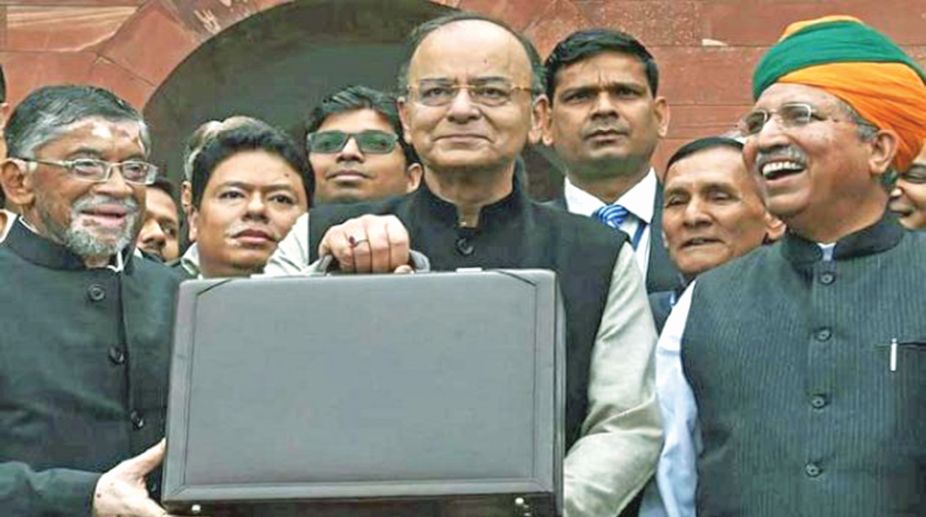After CM prod KMC councillors to start scrutiny of voters’ list
Mayor Firhad Hakim and the councillors of Kolkata Municipal Corporation are soon to hit the ground scrutinising the voters’ list in various wards of the KMC.

Finance Minister Arun Jaitley
Finance Minister Arun Jaitley faced a tough balancing act between economic virtue and political compulsions when he presented India’s Budget last week. Getting the balance right was imperative as this was the Modi government’s last full Budget before parliamentary elections due next year.
Faced with growing pressure to placate the poor, who are getting increasingly restive about the lack of jobs, agricultural distress and generally about being left out of the benefits of rapid growth, Mr Jaitley relaxed the reins on fiscal discipline.
Advertisement
By far the biggest policy initiative in the Budget was a sweeping plan to provide health insurance to 100 million households for up to Rs 500,000 per year. For a country with a per capita income of just $1,800 and where most do not have any health insurance, the proposed measure will provide a much needed safety net which, the ruling Bharatiya Janata Party would hope, will translate into votes come election time.
Was the spending justified? World Bank statistics from 2014 show that India’s public spending on health is just around 1.4 per cent of gross domestic product, compared with China’s 3.1 per cent, Sri Lanka’s 3.0 per cent and Ethiopia’s 2.9 per cent. While such funding is justified, how it is spent is equally important.
Advertisement
Some experts might argue that it would have been better to invest the money in improving public health, tackling issues of poor sanitation and nutrition. Millions of children in India still die of preventable diseases such as diarrhoea, pneumonia and malaria. While the initiative would increase the access of people to healthcare, questions remain over the quality of the latter. Questions too remain on how the generous healthcare plan will be funded.
The Budget also promised to raise the minimum support price – the price at which the government undertakes to buy farmers’ produce should the market price go below that level – to guarantee the farmers a profit of at least 50 per cent. This is certainly farmer-friendly. However, the fiscal impact of the largesse could be huge. Besides, the measure raises the risk of stoking inflation and distorting crop choices, evidencing once again that there are no benign options in public policy.
Prime Minister Narendra Modi swept into office in 2014 by promising millions of youth that he would create jobs. Four years later, the promise remains just that – a promise. The Finance Minister announced plans to raise government funding of employee provident fund contributions for new employees for the next three years. This, arguably, should increase formal employment by reducing the cost of employers’ statutory obligations. However, to what extent it would dent unemployment is uncertain. With 12 million youth joining India’s labour force each year and the number of jobs created being barely half of that figure, the future looks grimmer by the day.
The big answer to India’s employment challenge lies in raising investment, which remains subdued due to the “twin balance sheet” problem: Corporates are too weighed down by stressed balance sheets to borrow afresh and banks are burdened by bad debt to make fresh lending. A few months earlier, the government announced a sizeable plan to recapitalise public sector banks. Investment sentiment should revive as balance sheets get repaired. When exactly the turnaround will come remains as yet uncertain.
Potential investors were disappointed with the Budget not offering any relief on corporate taxes. Furthermore, long-term market earnings were squeezed by the reintroduction of the long-term capital gains tax on
equities.
On Mr Modi’s watch, India has improved markedly on the World Bank’s “ease of doing business” rankings by climbing up 30 places last year to break into the top 100. However, the rank is still too low for a country that aspires to replicate, if not rival, China’s spectacular success as a manufacturing power house.
Among the many things that hurt India on the “ease of doing business” front is a credibility gap. At last month’s World Economic Forum in Davos, Mr Modi decried protectionism. This was completely out of sync with the Finance Minister’s decision to raise Customs duties on a host of items in the Budget. Even as he has left big expenditure initiatives largely unfunded, Mr Jaitley struggled to balance his books. He has breached on previously agreed fiscal deficit targets both for the current year and next year. For good or bad, it is now standard practice for interlocutors on India to judge the government’s reform credentials by judging its commitment to fiscal responsibility. The Budget has not passed the test.
It is evident that the political urge to appease core constituencies like farmers and salaried employees has led to compromise on fiscal discipline. The fiscal slippage will complicate macroeconomic management by putting pressure on interest rates and inflation, and choke investment sentiments.
According to the International Monetary Fund’s forecast, India will grow at 7.4 per cent this year. This will make India the world’s fastest growing large economy. However, from here to becoming a middle income country with widely shared prosperity is a long way off. How he leads India on this journey will define Mr Modi’s legacy. The Budget, long on promise but short on policy or resources, is not a sure-footed start.
The writers are, respectively, a former Governor, Reserve Bank of India and now distinguished visiting research fellow at the Institute of South Asian Studies (ISAS) at the National University of Singapore, and a senior research fellow with ISAS. The Straits Times/ANN
Advertisement